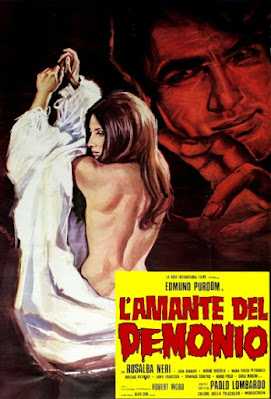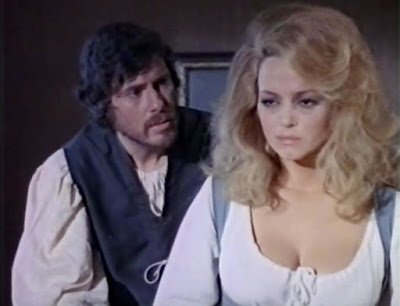“Now I have you with me, under my power. Our love grows stronger now with every hour. Look into my eyes, you will see who I am. My name is Lucifer, please take my hand.” – Black Sabbath
When Satan comes to town, he sets his sights on the biggest catch in The Devil’s Lover, or my personal favorite alternate title Lucifera: Demonlover.
I don’t know why, but it’s taken me many years to revisit this Italian gothic horror. The last time I watched it was in 2009 when I picked up the pan-and-scan Mya DVD. Despite the poor picture quality, I was happy to have it, as I probably wouldn’t have ended up knowing about it otherwise, but I am surprised the film never had an upgrade since. As far as I can tell, the only way to see it in 2022 is still as a censored and murky full screen film [Update (December 2023): Severin has released this film on Blu-ray uncut and restored in Volume 2 of their amazing Danza Macabre Italian gothic horror boxsets].
Even though it was restrained, my fondest memory of this film was the grand love scene between a nude Rosalba Neri and a clothed, caped Devil figure, played by Edmund Purdom. I was in awe at the visual of Rosalba’s sideways lying profile figure that was partially shrouded by the devil’s cape as he embraced her. It certainly has the same kind of energy as the classic reclining nude paintings, such as La Grande Odalisque (1814) by Jean-Auguste-Dominique Ingres or The Rokeby Venus (1647-1651) by Diego Velázquez.
A colorful looking ‘70s gothic horror like The Devil’s Lover is an easy sell given the look, title, poster art, and cast of the film, but the film itself does feel incomplete and amateurish. It tries to deliver the goods, but it’s usually not enough. For me personally, it contains everything I usually want, but it doesn’t go as hard with it as I’d like. Just as it starts to show promise, it usually pulls back. This might have something to do with the censorship the film was subject to. Despite this, it still has its moments as well as a few nice touches and a fun playfulness at times. It checks off most of the gothic Eurohorror boxes, so it is a comfort film for me. The film’s also of note for featuring Italian movie goddess Rosalba Neri in a double lead role of sorts. Fortunately, Rosalba doesn’t disappoint and her heart seems to be in it. She does deserve better and has certainly been in better, but she’s a delightful and evocative presence that does make this movie more noteworthy than it otherwise would’ve been. We’ve also got Edmund Purdom as a lustful devil figure with some seriously formidable sword dueling skills. These kind of romantic but perilous Satan characters were a thing in the late ’60, early 70s, especially as a substitute for the love interest in gothic romance novels.
The mood and setting do get your attention at the start. Young, beautiful, and chic women vs. a creepy antique castle, it’s definitely what we’re here to see, but it does take an unexpected yet interesting turn as a flashback story.
Rosalba Neri and her two other gorgeous lady friends make for a lovely entrance onto the grounds of a castle (the Castello Ruspoli). They are crashing this castle because they heard it belonged to the devil and are looking to debunk this legend by staying the night. Seems reasonable enough.
They find a hospitable intendant who treats them to an atmospheric candlelit dinner. After being spooked at dinner, Rosalba (her present-day character isn’t named, so I’m calling her Rosalba) retires to her room and slips into a gothic night gown for bed. Later that night, she explores the castle halls with candelabrum in hand before being startled by an old portrait of a woman in flames, who Rosalba believes is herself. The castle seems to menace her at this point, causing her to pass out and awaken in the Middle Ages, into a kind of dream that’s taken possession of her, as the movie makes an abrupt tone-change here, transitioning into a period piece that actually makes up the bulk of the film. That’s right, we’re not coming back to the castle for a long time.
Despite being bewildered at first, she becomes the soon-to-be-married virgin Helga from a small (German, judging by the names of the characters) village. What’s interesting is that in the present Rosalba has fallen into a dream to now become her counterpart from centuries prior, who is waking up from a dream in a sunny open field (that surreal and disorienting shift from a night to a day perspective always gets me). As Helga, she is a maiden engaged to a man named Hans (Ferdinando Poggi). There’s also a mystery fellow in a red hood that sometimes shows up in the background to disturb the otherwise idyllic scenario.
I was intrigued to see that Robert Woods, who I know from several Jess Franco films, is on hand as Helmut, a sword dueling romantic in tights. Helmut loves and pursues a woman named Magda (Maria Teresa Pingitore), who is instead in love with Hans, but Hans loves his bride-to-be, Helga. This love square is the central conflict for a while, so we do get a little in to soap opera territory for a time before the more fantastical elements come forward again to put the film on its path to a promised “grand guignol” finale.
The more fantasy and sinister side of the plot is set forth when Helga learns of the superstitious belief from her mother that if any other man were to see Helga’s wedding dress before the future husband, the marriage would be cursed with the evil eye. And of course, shortly after, the mysterious man in the crimson hood sees Helga’s dress while peering into the window, cursing the wedding dress for certain. The bad vibes need to be lifted, so Helga seeks a witch in the woods to cleanse her contaminated wedding dress. The outcome to this solution is unsavory but still entertaining since it somehow leads to a ritualistic cave orgy scene with witches and vampires that passes by faster than I would’ve liked.
Helga seems to become more enchanted by the curse, ending up in an apathetic state during the pre-wedding celebration after the red hooded man eventually reveals himself to be a handsome Dracula looking gentleman named Gunther (Purdom), who Helga seems to have an attraction to despite her better judgement. What’s a girl to do when the devil is after your virginity? I do like the cutaway effect before she first meets him, where Helga’s vampirized friends accost her only as a means to magically whisp her away to his lair, an old desecrated church, where he can introduce himself and incite her to ambivalent temptation and plant in her an unhealthy obsession for him. In other words, put her under his spell.
The Devil’s Lover is a winner in style but falls short in execution. An affair with the prince of darkness himself is a neat idea that really works for this kind of movie, but alas the chemistry between Neri and Purdom is superficial at best, which I don’t think is the actors’ faults. The story just doesn’t really give them enough time to be around each other enough to generate much chemistry. She met him once and is ready to forget her marriage and do his bidding to prove that her love for him is real. It’s a spell, so it requires some suspension of disbelief. Their more intimate encounter towards the end is more or less a set piece/spectacle that I thought was still the most memorable part.
The music from Elvio Monti isn’t bad and is as low budget sounding as the film itself. I personally like it, as it has a charming kitschy quality to it as well as a folk sound at times that works well for the flashback setting. It doesn’t really quite save the film, but the cheap, almost stock sounding, music does weirdly complement the overall cheapness of the film. There's a story teller jester who enters a scene by dancing down the road while playing the film's recognizable main theme on the flute, so it convinces me the music was composed for this film and is not stock music.
The medieval flashback setting has all of the production value of a backyard Renaissance Faire, but for viewers in the right mindset this is one of the film’s charms. The sword fighting choreography isn’t bad, but unfortunately, the special effects are very minimal (perhaps another casualty of censorship?), and the vampires are on screen for only a few seconds, but as a supernatural period-piece with exploitation trappings, there’s still some fun to be had for patient fans of satanic Eurohorror and Rosalba Neri. However, the fun parts are short and tend to underdeliver.
Like I was saying earlier though, this one’s easy to package and sell but also difficult to recommend.
© At the Mansion of Madness
















No comments:
Post a Comment